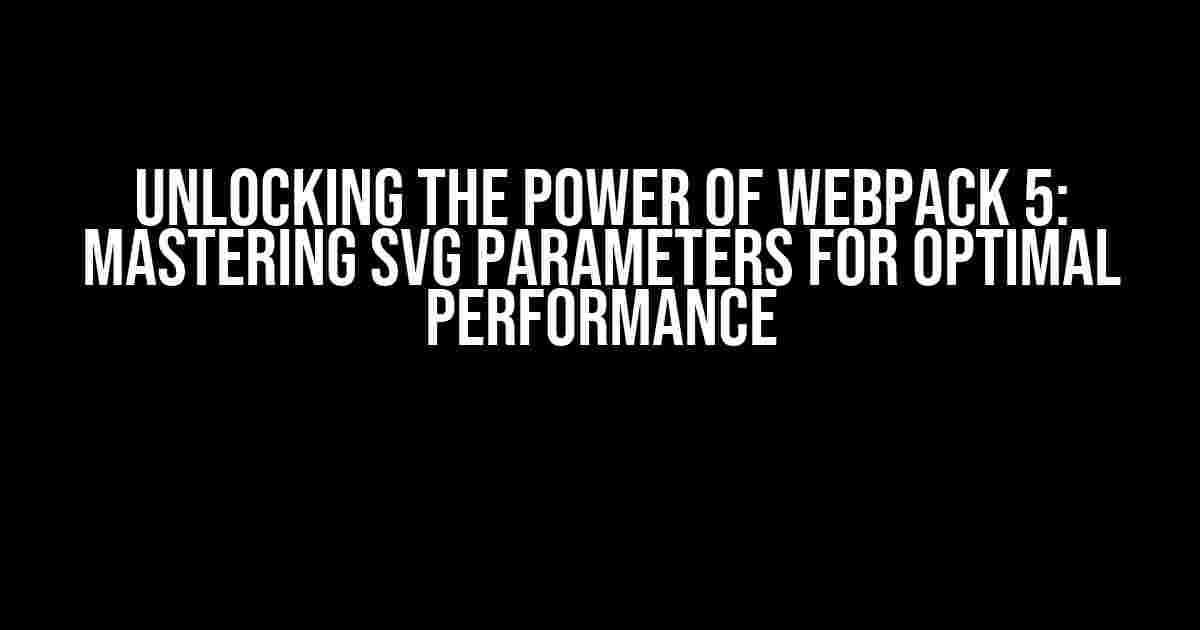Hey there, fellow developers! Are you tired of dealing with bloated SVG files and sluggish performance in your web applications? Well, buckle up, because we’re about to dive into the wonderful world of Webpack 5 and SVG parameters! In this comprehensive guide, we’ll explore the ins and outs of optimizing SVG files using Webpack 5, and how to harness the power of SVG parameters to take your web development skills to the next level.
What are SVG Parameters?
Before we dive into the juicy stuff, let’s take a step back and understand what SVG parameters are. SVG, or Scalable Vector Graphics, is an XML-based file format used to create vector graphics for the web. SVG parameters refer to the attributes and properties that define the appearance and behavior of an SVG element. By tweaking these parameters, you can control everything from the fill color and stroke width to the animation and interaction of your SVG elements.
Why Optimize SVG Files?
So, why is optimizing SVG files so important? Well, here are just a few compelling reasons:
- Reduced file size**: Optimized SVG files lead to smaller file sizes, which means faster page loads and improved performance.
- Better rendering**: Optimized SVG files ensure that your graphics render correctly and consistently across different browsers and devices.
- Improved SEO**: Optimized SVG files can improve your website’s search engine ranking by reducing page load times and improving user experience.
Introducing Webpack 5: The Ultimate SVG Optimizer
Webpack 5 is a powerful module bundler that revolutionizes the way we handle SVG files. With its built-in support for SVG optimization, Webpack 5 makes it easy to optimize your SVG files and unleash their full potential. But how does it work?
Webpack 5 uses a combination of plugins and loaders to optimize SVG files. The most popular plugin for SVG optimization is the svgo-webpack-plugin, which integrates the popular SVGO SVG optimizer with Webpack. This plugin uses a combination of algorithms and techniques to simplify and compress SVG files, resulting in smaller file sizes and improved performance.
Configuring Webpack 5 for SVG Optimization
So, how do you configure Webpack 5 to optimize your SVG files? It’s easier than you think! Here’s a step-by-step guide to get you started:
- Install the required plugins**: Run the following command in your terminal to install the
svgo-webpack-pluginplugin:npm install svgo-webpack-plugin --save-dev - Configure Webpack 5**: Add the following configuration to your
webpack.config.jsfile:module.exports = { // ... other configurations ... module: { rules: [ { test: /\.svg$/, use: [ { loader: 'svgo-loader', options: { plugins: [ { removeViewBox: false, }, { removeDimensions: true, }, ], }, }, ], }, ], }, }; - Optimize your SVG files**: Run the following command to optimize your SVG files:
npx webpack
Tuning SVG Parameters for Optimal Performance
Now that we’ve optimized our SVG files using Webpack 5, let’s dive deeper into the world of SVG parameters. By tweaking these parameters, we can further optimize our SVG files for improved performance and rendering.
Finding the Right Balance: SVG Parameter Optimization Techniques
When it comes to optimizing SVG parameters, there are several techniques you can use to achieve optimal performance. Here are a few tips and tricks to get you started:
| Svg Parameter | Description | Optimization Technique |
|---|---|---|
| Fill color | Defines the fill color of an SVG element | Use a consistent color palette and reduce the number of fill colors to minimize file size |
| Stroke width | Defines the width of an SVG element’s stroke | Use a consistent stroke width and reduce the number of stroke widths to minimize file size |
| Animation | Defines the animation properties of an SVG element | Optimize animation by reducing the number of animation frames and using efficient animation techniques |
| Interactivity | Defines the interactive properties of an SVG element | Optimize interactivity by reducing the number of interactive elements and using efficient event handling techniques |
Real-World Examples: Optimizing SVG Parameters in Action
Let’s take a look at a real-world example of optimizing SVG parameters. Suppose we have an SVG icon with a complex path and multiple fills:
<svg viewBox="0 0 24 24">
<path d="M12 2C6.48 2 2 6.48 2 12C2 17.52 6.48 22 12 22C17.52 22 22 17.52 22 12C22 6.48 17.52 2 12 2Z" fill="#fff"></path>
<path d="M12 6L12 18" stroke="black" stroke-width="2"></path>
<circle cx="12" cy="12" r="4" fill="red"></circle>
</svg>By optimizing the SVG parameters, we can simplify the SVG code and reduce the file size:
<svg viewBox="0 0 24 24">
<path d="M12 2C6.48 2 2 6.48 2 12C2 17.52 6.48 22 12 22C17.52 22 22 17.52 22 12C22 6.48 17.52 2 12 2Z" fill="#fff"></path>
<circle cx="12" cy="12" r="4" fill="red"></circle>
</svg>In this example, we’ve removed the unnecessary stroke and optimized the fills to reduce the file size and improve rendering performance.
Conclusion
And there you have it, folks! With Webpack 5 and SVG parameters, you can unlock the full potential of your SVG files and take your web development skills to the next level. By optimizing your SVG files and tweaking the right parameters, you can achieve fast page loads, improved performance, and stunning visuals. Remember to experiment with different techniques and optimize your SVG parameters to find the perfect balance for your project.
Happy coding, and don’t forget to optimize those SVG files!
Here is the HTML code with 5 questions and answers about Webpack 5 and SVG parameters, written in a creative voice and tone:
Frequently Asked Questions
Get ready to level up your Webpack 5 and SVG skills with these frequently asked questions!
What’s the big deal about Webpack 5 and SVGs?
Webpack 5 brings a ton of improvements to the table, and one of them is its ability to optimize SVGs like a pro! With Webpack 5, you can now easily optimize and compress your SVG files, reducing their file size and boosting performance. It’s a game-changer for developers who want to create fast, lightweight, and scalable websites.
How do I configure Webpack 5 to optimize my SVGs?
Easy peasy! You can configure Webpack 5 to optimize your SVGs by adding the `svgo-loader` to your module rules. This loader uses SVGO, a popular SVG optimization tool, to compress and optimize your SVG files. Simply add `{ test: /\.svg$/, use: ‘svgo-loader’ }` to your `module.rules` array, and you’re good to go!
What are some common SVG parameters that I can optimize with Webpack 5?
Webpack 5 allows you to optimize a range of SVG parameters, including path simplification, merge paths, and removing unnecessary attributes. You can also optimize image compression, convert shapes to paths, and much more. By optimizing these parameters, you can significantly reduce the file size of your SVGs and improve page load times.
Can I use Webpack 5 to optimize SVG sprites?
You bet! Webpack 5 is perfect for optimizing SVG sprites. By using the `svg-sprite-loader`, you can create and optimize SVG sprites with ease. This loader allows you to create a single SVG file that contains multiple icons or graphics, which can be used throughout your website. It’s a great way to reduce HTTP requests and improve performance.
Are there any best practices for optimizing SVGs with Webpack 5?
Absolutely! When it comes to optimizing SVGs with Webpack 5, it’s essential to follow best practices. Make sure to use the `svgo-loader` to compress and optimize your SVGs, and consider using a plugin like `mini-svg-plugin` to further reduce file sizes. You should also optimize your SVGs in development mode to ensure that they’re compressed correctly. Finally, don’t forget to test your optimized SVGs in different browsers to ensure compatibility.







